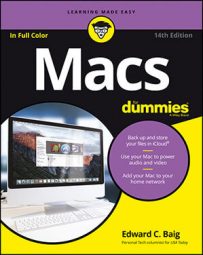Mac versus Windows terminology
A Mac operating system and a Windows operating system generally perform the same basic tasks. Those operations just have different names and are found in different places. This table shows the rough equivalents between the two.
| Mac Term | Rough Windows Equivalent |
|---|---|
| Utilities, Applications | Accessories |
| Option key | Alt key |
| Command key | Control key |
| System Preferences | Control panel |
| System Information | Device Manager |
| Quit | Exit |
| Dashboard widgets | Gadgets |
| Pictures folder | My Pictures/Pictures |
| Applications folder | Program Files |
| Get Info | Properties |
| Trash | Recycle Bin |
| Alias | Shortcut |
| Dock | Start menu and taskbar |
| Finder | Windows Explorer |
Common Mac keyboard shortcuts
If you don’t want to scroll through menus looking for a particular command, you can use handy Mac keyboard shortcuts to do things with a key press or two . . . or sometimes three.
| Command | Shortcut |
|---|---|
| New Finder Window | Command+N |
| New Folder | Shift+Command+N |
| New Smart Folder | Option+Command+N |
| Open | Command+O |
| Close Window | Command+W |
| Get Info | Command+I |
| Duplicate | Command+D |
| Make Alias | Command+L |
| Add to Sidebar | Control+Command+T |
| Eject | Command+E |
| Find | Command+F |
What to do when your Mac freezes
You know that frustrating, annoying, sometimes panicked feeling you get when your computer isn’t doing what you expect? If an application freezes or your Mac is generally misbehaving, try these tips to escape with minimal disruption.
-
Use Force Quit when an application is unresponsive. Choose Force Quit from the Apple menu or press Command+Option+Esc keys. Click the name of the deviant application (it probably has not responding next to its name). You typically won’t have to reboot.
-
Restart. If Force Quit doesn’t bail you out, try rebooting the computer. If a frozen Mac prevents you from clicking the Restart command on the Apple menu, hold down the power button for several seconds or press the Control+Command keys and then press the power button. If all else fails, pull the plug, but remember that powering down without logging out should be used only as a last resort.
-
Restart in Safe Mode. Press the power button to turn on your computer, and then press and hold the Shift key the instant you hear the welcome chime. Release Shift when the Apple logo appears. You will see a status bar as the computer boots, after which the words Safe Boot appear in red in the upper right corner of OS X’s login screen. In Safe mode, the Mac unleashes a series of troubleshooting steps designed to return the computer to good health. If Safe Boot resolved the issue, restart the Mac normally the next time.
5 Mac features to check out
Macs are full of fun and useful applications. Check out the following features as you need them or have the time. Your Mac adventures await.
-
Macs play chess. Challenge the computer or watch the computer challenge itself (Applications).
-
Macs are multilingual. Display menus and dialog boxes in more than two-dozen foreign languages. (Choose Language & Region in System Preferences.)
-
Macs recognize speech. Use your voice to open applications, choose menu items, send email and dictate text. (Choose Dictation & Speech in System Preferences.)
-
Macs enable you to use parental controls. Specify websites your kids can visit, people they can email or chat with, and applications they can run. (Choose Parental Controls in System Preferences.)
-
Macs allow video conferencing. Hold a video conference through Messages (Applications) or see your pals on video calls to iPhones , iPads, iPod touches, and other Macs through FaceTime.

